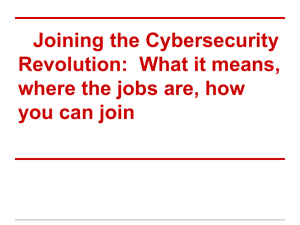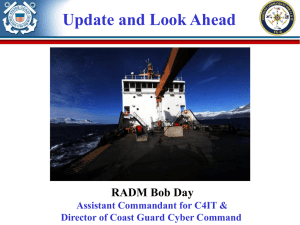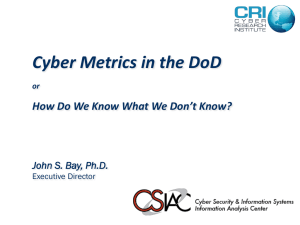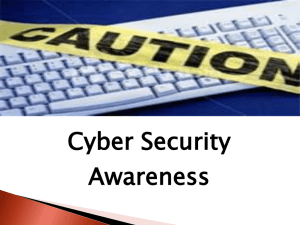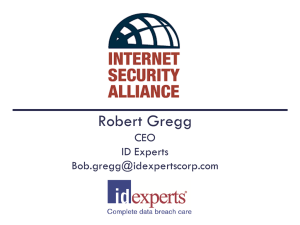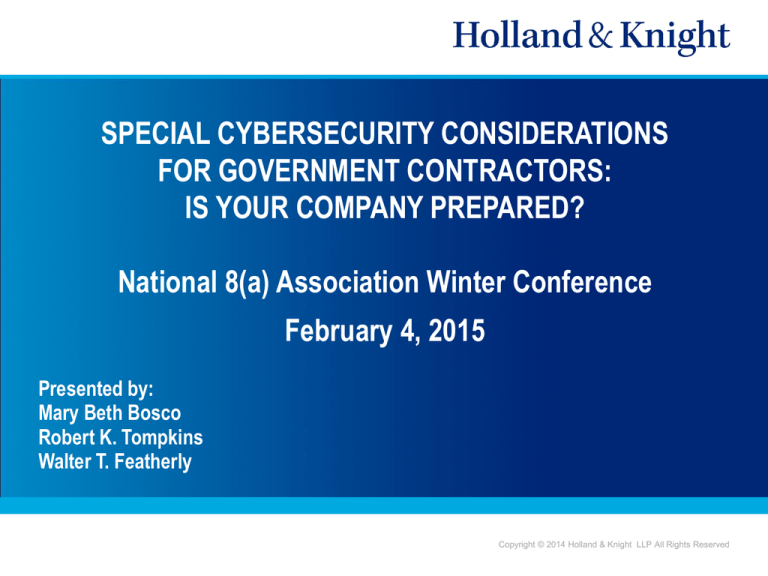
SPECIAL CYBERSECURITY CONSIDERATIONS
FOR GOVERNMENT CONTRACTORS:
IS YOUR COMPANY PREPARED?
National 8(a) Association Winter Conference
February 4, 2015
Presented by:
Mary Beth Bosco
Robert K. Tompkins
Walter T. Featherly
Copyright © 2014 Holland & Knight LLP All Rights Reserved
PART 1: OVERVIEW OF CYBERSECURITY
REQUIREMENTS
Copyright © 2014 Holland & Knight LLP All Rights Reserved
2
Overview Of Cybersecurity Requirements
I.
What Are the Risk Areas?
II. What Are the Moving Pieces?
III. What Are the Current Requirements for Government
Contractors?
IV. What Should Your Company Expect in 2015?
3
Section I
What Are The Risk Areas?
–
–
–
–
Sensitive government information resides on private sector
computer systems.
There is no uniform requirement for reporting of cyber breaches to
the Government.
Congressional and GAO reports find that government agencies
are not aware of breaches in their contractors’ systems.
Multiple agencies have cyber responsibilities, resulting in
sometimes confusing and overlapping requirements.
4
Cyber Breaches Are In The News Every Day
•
According to FBI Director James Comey, “There are two
kinds of big companies in the United States. There are
those who’ve been hacked…and those who don’t know
they’ve been hacked.”
•
•
•
•
•
•
•
•
•
•
JPMorganChase
Staples
Target
Neiman Marcus
Home Depot
JC Penney
NY Times
USIS
Dairy Queen
SnapSave
Michaels
Ebay
Yahoo!
AT&T
US Steel
Westinghouse
Evernote
Goodwill Industries
Apple iCloud
SuperValu
5
The Government And Its Contractors Face Unique Risks
Of Cyber Incursions
•
Cyber threats to government operations are widespread:
– Foreign governments regularly probe DOD and private contractor
networks to identify vulnerabilities, establish a foothold for future
exploitation or collect intelligence or trade secrets.
– Breaches of what are traditionally thought of as private sector
networks potentially impact defense operations. For example,
private airlines provide more than 90 percent of DoD’s passenger
movement and more than one-third of its bulk cargo capability.
– In 2012, the 24 agencies covered by the Chief Financial Officers
Act reported that 33 percent of all personnel performing IT security
work for the government were contractors.
6
Government Oversight Over The Intersection Of Its
ITSystems And Its Private Contractors Is Mixed
•
The titles of these GAO reports tell the story:
– 2005 GAO Report, “Information Security: Improving Oversight of
Access to Federal Systems and Data by Contractors Can Reduce
Risk.”
– 2013 GAO Report, “Federal Information Security: Mixed Progress
in Implementing Program Components; Improved Metrics Needed
to Measure Effectiveness.”
– 2014 GAO Report, “Information Security: Agencies Need to
Improve Oversight of Contractor Controls.”
7
Despite Risk, Government Doesn’t Know What It Doesn’t
Know About Its Contractors’ Systems
•
•
No uniform cyber breach reporting requirements exist for
government contractors.
Agency coordination is improving, but gaps exist.
– For example, an MOU between DoD and the FBI requires the FBI
to inform DoD when it becomes aware of a cyber breach involving
an Advanced Persistent Threat (“APT”) and a DoD contractor – but
the FBI does not necessarily know who is a DoD contractor, much
less who is an operationally critical contractor. DSS is currently
providing the FBI with its database of cleared contractors.
8
Lack Of Uniform Reporting Requirement Creates
Potential Vulnerabilities
–According to a recent SASC Report, “Inquiry into Cyber
Intrusions Affecting U.S. Transportation Command
Contractors,” there were 50 successful cyber incursions or
other events involving TRANSCOM contractor systems
between June 2012 and May 2013. Of these, 20 were
attributed to APTs – from China. TRANSCOM was only
made aware of two of the events.
–This report led to a new provision in the NDAA for 2015
that requires “operationally critical” contractors to report
cyber incursions. (More on this later….)
9
Section II
What Are the Moving Pieces?
–
–
–
–
Multiple agencies and players have overlapping roles.
Different statutory and regulatory schemes also
overlap.
Congressional action and/or inaction has led to
uncertainty.
The Cyber Framework is voluntary.
10
Problem 1: Who’s On First?
•
Multiple agencies have overlapping roles:
– The Federal Information Security Management Act
(“FISMA”) of 2002 gives OMB oversight of agency
information security policies and practices, assigns NIST the
role of developing security standards for agencies’ computer
systems (other than for national security systems), and
requires each agency to adopt information system
protections. The FISMA Modernization Act of 2014
expanded these roles (see below).
– The Cyber Executive Order assigns DHS an oversight role,
which is codified by the FISMA Modernization Act.
– Contracting agencies have their own cybersecurity
requirements and clauses. FAR 7.103(w) requires
agencies to include FISMA compliance in their
acquisition plans.
11
Problem 2: What’s On Second?...Not Congress Yet
•
Congress has yet to act in a comprehensive way.
•
The last major piece of cybersecurity law to be passed by Congress
and was the E-Government Act of 2002, which included FISMA.
Computer Security Act of 2012 came close to passage, but died in
the Senate in August 2012. Issues were:
•
– Opposition to industry-wide standards, even if voluntary.
– Data privacy concerns.
– Liability protections for compliant companies.
•
To be fair, five discrete cybersecurity bills passed in 2014 and were
signed by the President on December 19, 2014. These are:
– S1353: The Cybersecurity Enhancement Act of 2014, which is unfunded and
expressly states it does not create any regulatory authority. It amends the National
Institute of Standards and Technology Act to require NIST to continue to support the
development of voluntary standards for critical infrastructure (which NIST is already
doing under the Framework). Also requires a Cyber R&D Strategic Plan every four
years.
12
2014 Cybersecurity Bills
-S2519: The “National Cybersecurity Protection Act of 2014.” Amends the
Homeland Security Act of 2002 to codify the existing Cybersecurity and
Communications Integration Center, which promotes the sharing – on a voluntary
basis – of information about cyber risks, incidents and analysis.
-HR2952: The “Cybersecurity Workforce Assessment Act.” Requires DHS to
conduct an annual analysis of the readiness and capability of its cybersecurity
workforce and develop a “comprehensive” workforce strategy. Really.
-S1691: The “Border Patrol Agent Pay Reform Act of 2014.” Also amends the
Homeland Security Act of 2002 to give DHS authority to establish excepted positions
from the SES for cybersecurity-related functions in order to make it easier to hire
cyber professionals.
-S2521: The “Federal Information Security Modernization Act of 2014.” Codifies
existing scheme of making OMB responsible for oversight of agency information
security policies and practices, coordination with NIST to develop standards and
guidelines, and oversee agency compliance. The Act requires the SecDef and DNI to
perform these functions for DoD and IC national security systems, respectively. Each
agency must submit an annual report to Congress, OMB and DHS detailing cyber
breaches, and must perform an annual “independent” audit of its cybersecurity policies
and practices. The audit must be performed by the agency Inspector General or by
an outside auditor.
13
Another Bad Metaphor: While Congress Fiddled….
•
The White House issued an Executive Order 13636,
“Improving Critical Infrastructure Cybersecurity” in
2013:
– Contains non-procurement-specific and procurement-specific
elements. The Framework will affect you one way or another:
• Focuses on protecting cyber information according to identification of
“critical infrastructure.”
• Directs NIST to develop a “Cybersecurity Framework” to reduce risks
to critical infrastructure. The framework is to be technology-neutral
and compliance with the resultant standards is to be voluntary.
• Agencies are to review the Framework and determine whether their
existing cyber controls are sufficient and whether their existing
authority authorizes establishment of the requirements of the Cyber
Framework on their regulated industries.
• Expands current Enhanced Cybersecurity Services sharing program
to owners and operators of critical infrastructure.
14
NIST Framework Is Voluntary
•
What does it do?
•
How does it do it?
“The Framework provides a common language for understanding, managing, and
expressing cybersecurity risk both internally and externally. It can be used to help
identify and prioritize actions for reducing cybersecurity risk, and it is a tool for aligning
policy, business, and technological approaches to manage that risk. It can be used to
manage cybersecurity risk across entire organizations or it can be focused on the
delivery of critical services within an organization. Different types of entities – including
sector coordinating structures, associations, and organizations – can use the
Framework for different purposes, including the creation of common Profiles.”
Framework Section 2.0.
– Framework Core: Identifies five activities – Identify, Protest, Detect, Respond,
Recover – helpful to managing cyber risk.
– Framework Implementation Tiers: These are categories of increasing cyber
protection schemes against which an organization can measure itself. The tiers
are: Partial, Risk Informed, Repeatable, and Adaptive.
– Framework Profile: Companies can use the core and implementation tiers to
prepare current profile and target profile, and develop an action plan to migrate
from current profile to target profile.
15
Framework – Non-Procurement
•
Who’s covered?
– Critical Infrastructure Sectors: Chemical; Commercial Facilities (i.e.,
sports arenas); Communications; Critical Manufacturing; Dams;
Defense Industrial Base; Emergency Services; Energy; Financial
Services; Food and Agriculture; Government Facilities; Health Care
and Health Services; Information Technology; Nuclear Reactors,
Materials, and Waste; Transportation; and Water and Wastewater
Systems.
– Each sector has an agency lead; each has a sector-specific plan from
2010.
– Voluntary now, but Executive Order requires each agency to review
the Framework and determine whether their existing cyber controls
are sufficient and whether their existing authority authorizes
establishment of the requirements of the Cyber Framework on their
regulated industries.
– At the very least, the Framework may be used as a “standard of care”
in data breach cases.
16
Executive Order Procurement-Specific Provisions
• Section 8(e):
“Within 120 days of this order, the Secretary of Defense and the
Administrator of General Services, in consultation with the
Secretary of the Federal Acquisition Regulatory Council, shall
make recommendations to the President…on the feasibility,
security benefits, and relative merits of incorporating security
standards into acquisition planning and contract administration.
The report shall address what steps can be taken to harmonize
and make consistent existing procurement requirements related to
cybersecurity.”
17
January 23, 2014 DOD/GSA Joint Report: “Improving
Cybersecurity And Resilience Through Acquisition”
•
Six recommendations:
– Institute baseline cybersecurity requirements as award conditions
for appropriate acquisitions.
– Address cybersecurity in relevant training.
– Develop common cybersecurity definitions for federal acquisitions.
– Institute a federal acquisition cyber risk management strategy.
– Require purchases from OEMs, authorized resellers, or “trusted”
sources.
– Increase government accountability for cyber risk management.
In addition, report states: “Cybersecurity standards used in
acquisitions should align to the greatest extent possible with
international standards….”
18
HUH? So Far, I’ve Heard Voluntary And Recommendation…
•
•
•
The Framework is voluntary, the DoD/GSA Report makes
recommendations, Congress hasn’t acted in a
comprehensive way…Are there any mandatory
standards on the books?
Yes – if you are a government contractor.
Contracting agencies are leading the way on
cybersecurity, and DoD is the league leader.
19
Section III
What Are the Current Requirements Imposed on
Government Contractors?
– DoD Requirements:
•
•
•
•
•
–
–
UCTI Regulations
Counterfeit Electronic Parts Regulations
NDAA 2013
NDAA 2015
DoD Directive 5205.16
Intelligence Contracts
Individual Agency Requirements
20
DFARS 204.73/Clause 252.204-7012: Safeguarding
Unclassified Controlled Technical Information Rule
•
•
“UCTI is technical information with military or space application that
is subject to controls on the access, use, reproduction, modification,
performance, display, release, disclosure, or dissemination.
Controlled technical information is to be marked with one of the
distribution statements B-through-F, in accordance with DoD
Instruction 5230.24, Distribution Statements on Technical
Documents. The term does not include information that is lawfully
publicly available without restrictions.”
Contractors must use:
– NIST Special Publication 800-53; or
– If a NIST control is not implemented, the Contractor shall submit to the
Contracting Officer a written explanation of how—
• The required security control identified in the following table is not applicable;
or
• An alternative control or protective measure is used to achieve equivalent
protection; or
– Apply other information security requirements when the contractor
reasonably determines that additional measures are needed based on an
assessed risk.
21
DoD UCTI Rule (con’t)
Reporting requirement:
The Contractor shall report as much information as can be obtained within 72 hours
of discovery of any cyber incident, that affects unclassified controlled technical
information resident on or transiting through the Contractor's unclassified information
systems.
Damage Assessment:
•
The contractor must conduct further review of its unclassified network for evidence of
compromise resulting from a cyber incident to include, but is not limited to, identifying
compromised computers, servers, specific data and users accounts. This includes
analyzing information systems that were part of the compromise, as well as other
information systems on the network that were accessed as a result of the
compromise;
•
Review the data accessed during the cyber incident to identify specific unclassified
controlled technical information associated with DoD programs, systems or contracts,
including military programs, systems and technology;
•
Preserve and protect images of known affected information systems and all relevant
monitoring/packet capture data for at least 90 days from the cyber incident to allow
DoD to request information or decline interest;
•
Support any DoD-conducted damage assessments, including providing system
access and information.
22
DoD Counterfeit Parts Rule
• DoD May 2014 Rule: Detection and Avoidance of
Counterfeit Electronic Parts
– Who is Covered?
• Contractors who are CAS covered – and their subcontractors regardless of
CAS coverage –and that supply electronic parts or products that include
electronic parts.
– What is a Counterfeit Electronic Part?
• An unlawful or unauthorized reproduction, substitution, or alteration that has
been knowingly mismarked, misidentified, or otherwise misrepresented to be
an authentic, unmodified electronic part from the original manufacturer, or a
source with the express written authority of the original manufacturer or
current design activity, including an authorized aftermarket manufacturer.
Unlawful or unauthorized substitution includes used electronic parts
represented as new, or the false identification of grade, serial number, lot
number, date code, or performance characteristics.
23
DoD Counterfeit Parts Rule (con’t)
• What is an Electronic Part?
– An integrated circuit, a discrete component (including, but not
limited to, a transistor, capacitor, resistor, or diode),or a circuit
assembly. The term ‘‘electronic part’’ includes any embedded
software or firmware.
• What are the Requirements?
– An acceptable counterfeit electronic part detection and avoidance
system.
– This system will be part of purchasing system audits. Failure to
have a compliant system may result is disapproval of the
purchasing system or withholding of payments.
– Contractors must report counterfeit parts when they become aware
of such parts or has a reason to suspect counterfeit parts.
24
DoD Counterfeit Parts Rule (con’t)
•
What are the limitations on sources of supply?
– Contractors can only use original manufacturers, sources with the
express written authority of the original manufacturer or current
design activity, including an authorized aftermarket manufacturer or
suppliers that obtain parts exclusively from one or more of these
sources.
•
Are costs allowable?
– The final rule establishes a new DFARS cost principle, 231.205-71,
that makes the cost of counterfeit electronic parts or suspect
counterfeit electronic parts and the cost of rework or corrective
action that may be required to remedy the use or inclusion of such
parts unallowable, unless the following exception is met: (1) the
contractor has a reviewed and DOD-approved operational system
to detect and avoid counterfeit parts and suspect counterfeit
electronic parts; (2) the counterfeit electronic parts or suspect
counterfeit electronic parts are government-furnished property; and
(3) the contractor provides timely (i.e., within 60 days after
becoming aware) notice to the government.
25
Other DoD Requirements
•
•
NDAA 2013: Requires mandatory reporting of cyber breaches by
cleared contractors.
NDAA 2015: Requires the Secretary of Defense to establish
procedures for mandatory reporting of cyber incidents experienced
by "operationally critical contractors.” This requirement was a result
of the 2014 SASC Report referenced earlier.
– Operationally critical contractors are those that are critical sources of
supply for airlift, sealift, intermodal transportation services, or logistical
support that is essential to the mobilization, deployment, or sustainment of
the Armed Forces in a contingency operation.
– DoD will designate and notify contractors falling within the definition of
operationally critical contractors.
– Rules due out in Q2 2015.
26
DoD Directive 5205.16, The DoD Insider Threat Program
•
•
•
Issued in September 2014.
Unlike other DoD Directives, it applies directly to
contractors.
States that the Under Secretary of Defense for
Acquisition, Technology, and Logistics is to develop
contract clauses “to ensure DoD contracts impose
uniform insider threat program requirements.”
27
Requirements For Intelligence Contractors
• 2014 Intelligence Authorization Act:
− Section 325 of the 2014 Intelligence Authorization Act requires the
DNI to establish procedures requiring cleared IC contractors to report
to the Government the successful penetration of a network or
information system.
− The new procedures must create a mechanism for IC government
personnel to obtain access to contractor equipment or information to
enable the government to conduct its own forensic investigation.
− The new procedures will be issued in 2015.
28
I Don’t Have DoD Contracts And I Don’t Have Classified
Work….Am I Still Covered?
•
In one word, “Yes.” Remember FISMA?
FISMA seeks to set forth a framework for ensuring the effectiveness of
information security controls over information resources that support federal
operations and assets, including those operated by contractors.
– Each agency must maintain an information security program that includes:
• Periodic risk assessments;
• Cost effective policies and procedures to address cybersecurity;
• Subordinate plans for networks, facilities, and information systems;
• Security awareness training;
• Periodic testing and evaluation;
• Remedial action where appropriate;
• Procedures for detecting, reporting, and responding to security incidents;
• Continuity plans.
– Under FISMA, agencies can require contractors to meet these standards.
29
Individual Agency Requirements
Agency
Written
Plan?
Reference
FISMA
Mandatory
Breach
Reporting?
Verification/
Self Audit
GSA
Yes
Yes
No
Annual
verification
State Dept
Yes
Yes
No
Annual
verification
HHS
Yes
Yes
No
IT Security &
Accreditation
DVA
No
Yes
No
Annual self
audit
DOT
Yes
Yes
No
Annual
verification
30
Individual Agency Requirements (cont’d)
Agency
Written
Plan?
Reference
FISMA?
Mandatory
Breach
Reporting?
Verification/
Self Audit?
HUD
Yes
Yes
Yes
No
Commerce
Security
Accreditation
Plan
No
No
No audit
FAR
No
No
Contractor
No
must report
new threats or
when existing
safeguards
have ceased to
function (FAR
52.239-1)
31
Section IV
What Should You Expect in 2015?
•
2012 FAR Amendment Is Still Pending.
•
NIST November 2014 Draft Special Publication 800-171 Establishes
Specific Standards.
•
NISPOM Revisions are Expected Soon.
32
What’s Next? 2012 FAR Proposal To Regulate
Cybersecurity: What Happened To It?
•
•
•
•
•
•
•
Government information may not be processed on computers without access
control or located in public areas.
Electronic information may be transmitted only on systems that utilize
technologies and processes that provide the best level of security and
privacy available, given facilities, conditions and threat level.
Transmission by voice or fax may only occur when the sender has a
reasonable assurance that access is limited to authorized recipients.
Systems must be protected by at least one level of physical barrier and one
level of electronic barrier, such as lock and key in conjunction with a
password, when not in the direct control of the individual user.
Media that is being released or discarded must be cleared and sanitized.
The contractor must provide at least the following means of intrusion
protection: Current and regularly updated malware protection, such as antivirus software and anti-spyware software; and prompt application of securityrelated upgrades and patches.
Information may only be transferred to those subcontractors with a
contractual need to have the information and who employ the safeguards
described in the clause.
33
November 2014 NIST Draft
•
•
NIST Draft Special Publication 800-171, “Protecting Controlled
Unclassified Information in Nonfederal Information Systems and
Organizations.”
Part of overall government effort to streamline classification and
handling of controlled unclassified information (“CUI”), which is
information subject to restrictions on dissemination, such as export
controlled-information, FOUO, or technical data:
– The National Archives and Record Administration (“NARA”) has promulgated
regulations (pending before OMB) to streamline and make uniform the government
categories of protected, unclassified information.
– The November NIST draft contains standards which government contractors who
handle CUI must meet.
– The FAR will be amended to incorporate the NIST standards, once finalized.
– Companies will want to review the standards included in the NIST draft to measure
against their current policies and procedures.
34
Additional Developments Expected in 2015
•
The Defense Security Service is expected to amend the National
Industrial Security Program Operating Manual (NISPOM) to require
companies that process or access classified information to establish
insider threat programs.
35
Summary: What Applies To Government
Contractors Now?
•
•
•
•
•
•
•
DFARS UCTI Rule, which references NIST 800-53.
DOD Counterfeit Electronic Parts rule.
NDAA 2013 mandatory reporting (no regs yet).
2014 Intelligence Authorization Act (no regs yet).
NDAA 2015 Requirements for Operationally Critical
Contractors (no regs yet).
Current FAR.
Individual Agency Regulations and Clauses.
36
PART II: PRACTICAL ISSUES FACING CONTRACTORS:
COMPLIANCE PROGRAMS AND CRAFTING
APPROPRIATE AGREEMENTS WITH
EMPLOYEES AND THIRD PARTIES
37
A. Updating Compliance Programs
• The Challenge: Developing and maintaining an
effective compliance program for cyber issues is
challenging because the standards are shifting
and aren’t well defined.
• The Solution: View the problem through the lens
of compliance program basics.
38
The Purpose Of Compliance Programs
• The primary focus of any compliance program is
to prevent and detect misconduct or breaches –
cyber security is no different
• Secondary purposes include:
– To ensure compliance with contractual obligations
– To mitigate or avoid monetary damages/consequences
– To preserve reputation
– To mitigate or avoid other sanctions or suspension and
debarment
39
Remember Compliance Program Basics
•
Sound compliance programs consist of important
common features:
– Written codes of conduct/procedures tailored to the
company’s circumstances
– Regular training for employees
– A senior official of the company being charged with
responsibility
– Periodic monitoring of the program
– Discipline for violations
– Compliance as a key to advancement
– Demonstrated commitment by Management
– Appropriate reporting and issue resolution policies
•
Each of these is relevant to addressing cybersecurity
compliance.
40
Assessing Risks And Requirements
•
Before you can develop written policies or training
materials, you have to assess risks and legal
requirements:
– Review your contracts
– Review relevant government regulations and policies
– Review industry standards and best practices
– Review your organization’s experience with cyber security
– Review your organization’s systems, structure and existing
compliance measures
– Consider related, existing compliance policies
•
See Part I for examples of where to look: NIST 800171 identifies the areas to be included in a cyber
assurance policy.
41
Written Policies
• Depending on agency requirements,
Cybersecurity should either be integrated into
your existing property, data and records
management policies or in a separate policy.
• Consider whether property, data and records
management policies are consistent with your
cybersecurity requirements.
• Disseminate revised policies when ready.
42
Training
• Use the content of your revised written policies to
guide training content.
• Make sure training is provided on a regular
basis, that participation is meaningful and
tracked, and that you document your efforts.
• Make sure content and methods of delivery are
effective and geared toward the audience.
43
Put A Capable Official In Charge
• The person needs to have real authority and the
respect of peers;
• The person needs to be knowledgeable and
have access to updates in the field;
• The person needs to have resources to carry out
their role (including sufficient time in their own
day); and
• The position needs to be incorporated into the
reporting hierarchy of your organization.
44
Review And Assess Your Program Regularly
•
Regular review (annually at least) is essential.
•
Be prepared to adjust or enhance your program
based on any of the following:
– Changes in your company’s characteristics (i.e., growth, new
product lines, new locations, etc.)
– Changes in your customers requirements (i.e., changes to
contracts, policies, etc.)
– Experience, including breaches, patterns of activity and so
on
– Changes in law or policy
•
Document your reviews and your program/policy
changes.
45
Make Sure There Are Consequences
• Violations must result in Consequences.
• Positive actions should be rewarded.
• Particularly if you are in a highly regulated area,
consider making this part of
– Employee reviews
– Hiring decisions
46
Tone From The Top (*and the Middle)
• Management should set a good example in…
– Their day-to-day behavior
– Participating in training and other compliance activities
– Their messaging to employees and the outside world
• Don’t’ forget middle management
– Employees interact with them more often in most cases
– They are essential in maintaining compliance and your
culture of compliance
47
Report, Track, And Resolve Incidents
•
•
•
•
•
•
Detecting potential issues is essential.
Make sure employees know where to go in the event of a
breach.
Make sure the party receiving the reports is equipped to
handle them properly and knows whether further
reporting is required.
Document all response efforts even if the conclusion is
no breach occurred or no action is needed.
Periodically review data in a macro sense to identify
risks, trends and needs for enhancement to your
program.
Consider providing summary reports to upper
management to track your experience.
48
B. Addressing Cybersecurity In Your Agreements
• Consider cyber requirements in contract
performance:
– Subcontracts
– JV agreements
– Teaming Agreements
• Try to lead in the “battle of the forms”
– To ensure you understand requirements
– Requirements meet your capabilities/systems
– To avoid inconsistent obligations
49
Employment Agreements And Policies
• Consider cyber in your employment agreements,
especially for positions related to contracts
covered by enhanced requirements.
• Consider cyber in your employee handbooks
(make sure good cyber practices are a basis for
continued employment).
• Consider cyber issues in your hiring decisions
and in your diligence.
• Consider the extent to which you should monitor
employee behavior (i.e., tracking emails, system
access, social media, etc.).
50
Third Party Agreements
• Consider cyber in your other third party
agreements, such as:
– Business Development support
– PEOs and Temp agencies
– Professional services providers (accountants, lawyers,
etc.)
– IT support (i.e., data storage and “The Cloud”)
51
Legal Instrument/Terms To Consider
•
What legal instruments/terms and conditions might help?
– NDAs
– Non-competes
– Employee handbooks and compliance program
materials
•
Restrictive legends on key documents and within certain
systems
– i.e., drafts of proposals
– Underlying cost and pricing data
– Other proprietary and confidential information
52
Insider Threats Are Possibly The Greatest Risk Area
• What remedies might you have?
– Contractual obligations
– Procurement Integrity Act -- limits to its application
– Trade Secrets Acts
– Other Business torts
• How will you document and prove your case?
• When do your problems become reportable to
the Government?
53
PART III: SPECIAL CONSIDERATIONS FOR 8(A)S
AND SMALL BUSINESSES AND FOR NHO,
TRIBAL AND ANC ORGANIZATIONS
54
Special Issues For 8(a)s And Small Businesses
• A few common special risk areas:
– Nascent IT systems -- are your employees still using
gmail for business purposes? Are non-employees
using your email domain?
– Reliance on part-time help (i.e., from PEOs) and BD
consultants.
– Work may be disbursed geographically -- how do you
maintain physical security?
– Who owns the server(s) your data resides on?
– Leverage (or lack of it) with contracting partners.
55
Special Issues For Tribal And ANC Organizations
•
A few additional common special risk areas:
– Shared/Common IT systems
• Government contracting entities sharing with commercial entities and holding/parent
companies.
• May have personal information about shareholders on the system as well.
• Subject to multiple compliance requirements and considerations.
– Shared Services
• How to account for Sister Company personnel with access to 8(a)’s data and IT
systems?
• Do Sister Companies and Administrative Support System Providers understand
government contracts and 8(a) compliance obligations?
– Detecting/Managing Breaches
• What if the breach occurs through a commercial subsidiary which uses the same IT
systems your government contracting subsidiaries use?
– disclosure/reporting duties
– Corporate Policies
• Often too generic to recognize differences between the types of entities.
56
Special Issues (cont’d)
• Why are these issues problematic?
– ACCESS, ACCESS, ACCESS!
• Who has access to the information on your systems?
– Employees
– Server owners
» If still using gmail or other email systems for business purposes,
access by providers
» Physical servers owned by another, access by the owners
– Part-time help and consultants
– Business partners
• Greater access creates greater risk for breach
– Contractual Obligations
– Legal Requirements
• Alaska breach disclosure statute (AS 45.48.010)
57
How To Manage The Risk?
• Stay Aware
– Changing environment
– Increased risks
– Emerging IT technology
– Changes in the Law
• Corporate Policies
– Types of policies to consider:
• Access to systems
– Who, when, why, how
• Use of devices (personal or company owned)
– Mobile device usage
» Passcodes, encryption applications
58
How To Manage The Risk (cont’d)
– Start from the top
• Board
– Like compliance, Board does not manage IT issues on daily basis, but:
» Ensures appropriate overarching policies in place, including cyber
security policies
» Monitors and assesses the implementation
» Holds senior management accountable for implementation and
performance
• Management
– Compliance and management of cyber issues as a factor in management
evaluation
• Subsidiary Management
– Is the policy workable?
59
How To Manage The Risk (cont’d)
• Consider cyber provisions in your Joint Venture
and Mentor Protégé agreements:
– Joint Ventures –
• Whose system will be used for JV performance?
• How do JV contract provisions impact your systems and compliance?
• Will JV partners be accessing one-another’s systems?
– Mentor-Protégé
• Consider making cyber security assistance part of your mentor protégé
agreement.
• Will there be shared access to systems as a result of your relationship, either
through contract performance or from mentoring assistance?
60
Questions?
61
Thank You!
62
Mary E. “Mary Beth” Bosco
Mary Elizabeth Bosco is a partner in Holland & Knight's Washington,
D.C., office. She has 30 years of experience working with new and
experienced government contractors, and focuses her practice on
advising such organizations in contract compliance, transactional matters
and how to navigate the federal marketplace.
With a substantial background in regulatory matters and litigation, Ms.
Bosco counsels clients on the drafting of procurement manuals and
implementation of compliance and training programs, including reporting
requirements as well as audits and procurement fraud investigations.
•
•
•
•
•
Mary Beth Bosco
Partner
800 17th Street, NW,
Suite 1100
Washington D.C., 20006
(202) 469-5270
•
Marybeth.Bosco@hklaw.com
Practice
Education
• Government Contracts • George Washington
University (J.D.)
• Congressional
Investigations
• Yale University, (B.A.,
cum laude)
• False Claims Act
Defense
Bar Admission
• District of Columbia
63
Robert K. Tompkins
Bob Tompkins is a partner in Holland & Knight's Washington, D.C., office
as Co-Leader of the National Government Contracts Practice. Mr.
Tompkins provides strategic advice and counsel to government
contractors, their management and investors. He is experienced in
government contract protests and disputes, government investigations
and related proceedings, mergers and acquisitions, matters related to the
U.S. Small Business Administration (SBA) government contracting
programs and providing general counseling to clients.
•
•
•
•
•
Robert K. Tompkins
Partner
800 17th Street, NW,
Suite 1100
Washington D.C., 20006
(202) 469-5111
•
Robert.Tompkins@hklaw.com
Practice
Education
Bar Admission
• Government Contracts
• False Claims Act
Defense
• Indian Law
• Congressional
Investigations
• Regulatory and Federal
Litigation
• Washington and Lee
University (J.D.)
• Washington and Lee
University (B.A.)
• Virginia
• District of Columbia
• Maryland
64
Walter T. Featherly
Walter T. Featherly is the executive partner of Holland & Knight's
Anchorage office. Mr. Featherly focuses his practice on Alaska Nativeand Native American-owned businesses. He regularly counsels boards of
directors and executives on matters including corporate law and
governance, the Alaska Native Claims Settlement Act, the Alaska National
Interest Lands Conservation Act, securities law, intellectual property
protection, government contracting, employment practices, finance and
real estate.
•
•
•
•
•
Walter T. Featherly
Partner
600 W. 5th Ave., Suite
700
Anchorage, AK 99501
(907) 263-6395
•
Walter.Featherly@hklaw.com
Practice
Education
• Compliance Services • Harvard Law School
• Corporate
(J.D.)
Governance
• St. John’s College
• Public Companies and
(B.A.)
Securities
• Indian Law
Bar Admission
• Alaska
65

